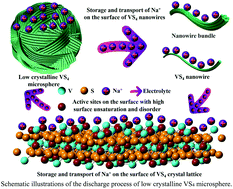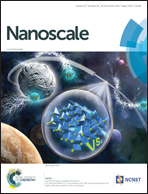3D self-assembled VS4 microspheres with high pseudocapacitance as highly efficient anodes for Na-ion batteries†
Abstract
Surface structure plays a decisive role in the surface capacity and electrochemical kinetics of rechargeable batteries. Tuning the surface structure of building blocks has been considered to be a new effective strategy to promote the electrochemical performance of 3D self-assembled nanoarchitectures. Herein, VS4 microspheres assembled from the nano-units with different crystallinities are synthesized via a facile template-free hydrothermal method. The results show that the electrochemical performance of VS4 microspheres as anode materials for sodium-ion batteries (SIBs) largely depends on their crystallinity, and a VS4 electrode with the lowest crystallinity delivers a high reversible capacity of 412 mA h g−1 at 0.2 A g−1 after 230 cycles and that of 345 and 293 mA h g−1 even at 1.0 and 2.0 A g−1, respectively. The insertion mechanism is revealed within the selected voltage window of 0.50–3.00 V. Further analysis suggests that decreasing the crystallinity of the nano-units can dramatically enhance the pseudocapacitive behavior of VS4 microspheres, which takes the main responsibility for the improvement of sodium storage properties. This work can provide a new insight for the exploration and design of high-performance anodes for SIBs.



 Please wait while we load your content...
Please wait while we load your content...